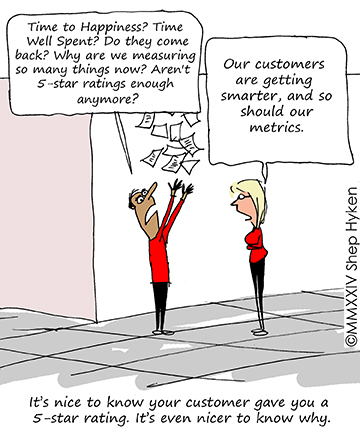Many of you who read my articles or watch my videos may not have jobs related to customer service or CX measurement, but that doesn’t mean you shouldn’t pay attention to what I’m about to share. I recently wrote an article that included 14 customer service and CX metrics that CX leaders should consider, and today, I’m going to cover three of them that anyone who has any interaction with a customer, whether in sales, support or just might happen to answer a customer’s call, should pay attention to. So, let’s jump into them:

-
Time to Happiness
The best way to describe this is how long it takes an upset, unhappy, or angry customer to return to being happy. Here’s why this is important to you, even if you aren’t in a customer-facing role. When customers come to you upset, frustrated, or even angry, they may not be reaching out at the moment the incident that triggered their negative emotions occurred. Maybe it happened two days ago, and they just now have the time to contact you or the company. It’s important to recognize that the moment they start to interact with you is in the middle of their time to happiness. Whether you take care of the issue yourself or pass it on to someone else, recognize that you play a very important role in the customer’s journey from experiencing a Moment of Misery™ to experiencing a Moment of Magic®.
-
Time Well Spent
Last year, I interviewed Aransas Savas on Amazing Business Radio. She is a customer experience designer at the consulting firm, Stone Mantel, where the TWS metric was created. Our customers’ time is precious, and we must respect it. Even if you don’t formally ask your customers in a survey, “Do you consider your experience with us to be time well spent?,” ask yourself, “Based on the conversation – or interaction – I just had with the customer, do you think they would give me a high Time Well Spent rating?” Yes, this is subjective, and it’s the customer’s opinion that matters, but keeping in mind that you’re creating value in the time your customer spends with you will help you focus on delivering your best customer experience.
-
Does the Customer Come Back?
This one will be familiar to you if you’ve been following my work. It’s right out of my book I’ll Be Back: How to Get Customers To Come Back Again and Again. Even with high scores on Time to Happiness, Time Well Spent, or any of the more typical and popular ways companies measure customer satisfaction, such as NPS, CSAT, and others, perhaps what may be the most important metric is if the customer comes back. So, like the Time Well Spent question, ask yourself, “Is what I’m doing right now going to get the customer to come back the next time they need what we sell?” This is my Loyalty Question, a concept I’ve shared many times over the years.
While all three of these customer service and CX metrics can formally be measured, most likely, you’re not the one doing the measuring. However, you have an important role in the result. So, recognize your part in the customer’s journey to happiness, respect their time, and create the experience that gets your customers to say, “I’ll be back!”
Related: Ford Versus Ferrari: A Lesson in Customer Experience

